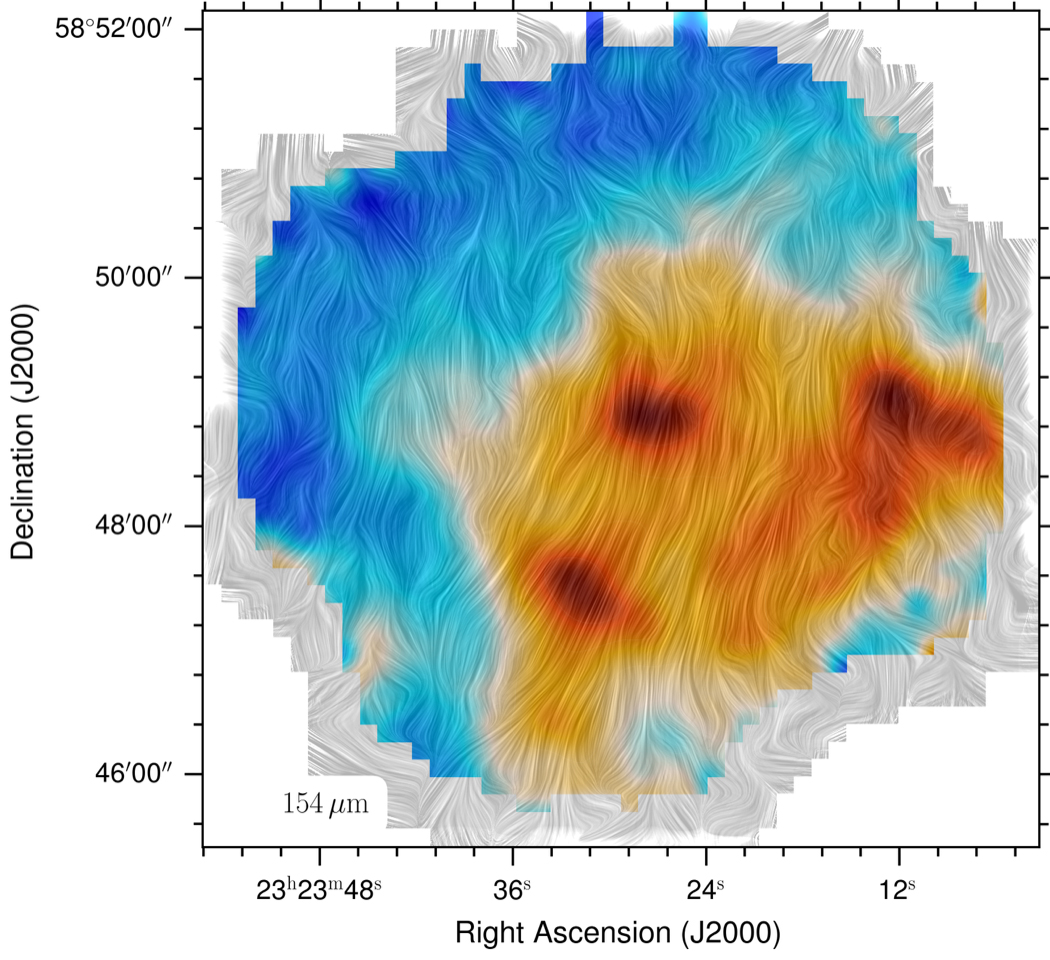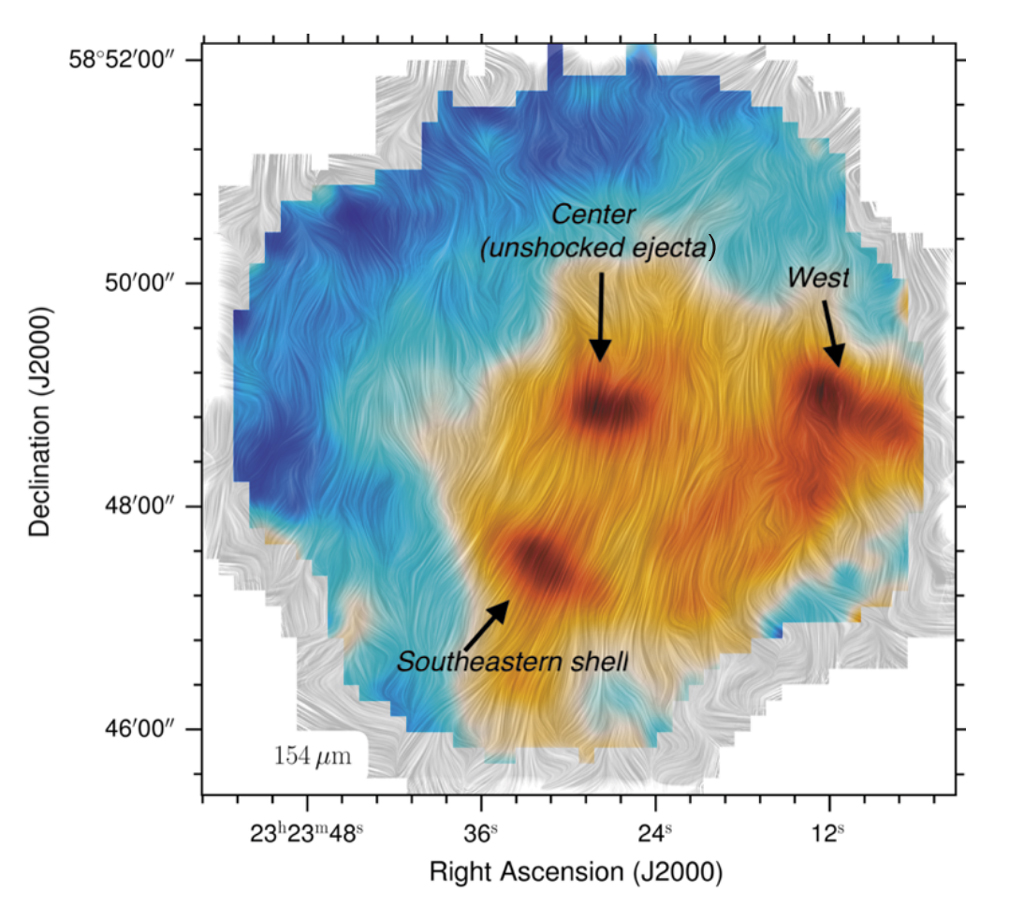
June 13, 2022, Mountain View, CA – New research detected strong polarization from a young supernova remnant. It provided independent and solid evidence that the cosmic dust in the early Universe was formed in supernovae. While it's true that supernovae eject and destroy cosmic dust, infrared observations now suggest that the dust formed at an early stage of a supernova. SOFIA HAWC+ (Stratospheric Observatory for Infrared Astronomy High-Resolution Airborne Wideband Camera Plus) Band D observations of the young supernova remnant (SNR) Cassiopeia A (Cas A) show high polarization at the 5-30% level. This polarization indicates:
- Polarized dust emission detected in far-infrared belongs to the SNR, and supernovae are producers of a large mass of dust (some papers, including in Nature, have indicated the dust is only from the clouds in the line of sight and there is no cold dust in Cas A)
- Newly formed dust grains in supernovae are large and elongated rather than spherical
- Silicate grains are the dominant dust to have such strong polarization
- Supernovae are important dust sources in the early Universe
Dr. Jeonghee Rho, a research scientist at the SETI Institute and the lead author of this research, said that the polarized dust emission belongs to the SNR Cas A and is not random interstellar emission. Studying far-infrared emissions is tricky since it is everywhere in the sky. Searching for emissions associated with supernovae is equivalent to finding a needle in the haystack. Polarization observations shine new light on that.
The research is a collaboration with the graduate student, Mr. Aravind Ravi, and other scientists at the University of Texas, Arlington, and collaborators are at the University College London and Cardiff University in U. K., Ghent University in Belgium, Max Planck Institute in Germany, and Korean Astronomy and Space Science Institute in South Korea.
Cassiopeia A is a relatively young SNR located in the constellation Cassiopeia and approximately 11,000 light-years away from Earth, and its light first likely reached Earth in around 1671 AD. It is also a well-studied SNR, making it an ideal observation target. SOFIA's HAWC+ is a far-infrared camera and imaging polarimeter that allows total and polarized flux imaging in five broad bands wavelengths. The polarization map of Cas A was conducted at 154 microns (Band D). By observing with this instrument, the researchers hoped to learn:
- How does the magnetic field flow?
- What type of dust grains are present?
- How large are the dust grains?
- What shapes are the dust grains?
- How does the dust align with the magnetic field?

By understanding the properties of the dust grains, scientists can better understand the history of star formation and the evolution of the Universe. Not to be confused with dust bunnies hiding under beds, cosmic dust is comprised of rocks and is made of elements like carbon, and in this case, mainly silicate, and plays a role in how stars and planets form. Theoretical models previously showed that dust formation in supernovae could explain the presence of dust in the early Universe. The big question was whether there would be evidence of sufficient amounts of dust forming.
SOFIA’s polarization in Cas A combining Spitzer and Herschel images implies an estimate of a magnetic field of approximately 100 milli-Gauss. It puts Cas A as one of the strongest magnetic field sources. The grain alignment in supernova ejecta occurs with the magnetic fields, and dust polarization can reliably trace the magnetic field.
The observation showed that silicate dust grains are the dominant grains in Cas A. This result is meaningful because the survival rate for silicate dust is higher than for other kinds of dust, so sufficient dust still exists behind the reverse shock. Other grains present could be iron-bearing dust, but additional wavelength observations or simulations will provide greater understanding.

The large amount of dust from the polarized regions of the SNR shows that supernovae are the significant dust producer in the early Universe. The dust mass from the polarized area (e.g., excluding the western part) is still two-tenths of Solar mass. Previously it was done using deconvolution of spectra. This data is independent confirmation that dust production from supernovae is important as dust producers in the early Universe.
“It’s disappointing that the SOFIA mission is coming to an end when we’re seeing exciting results such as this,” said Deputy Director of SOFIA Science Mission Operations, Bernhard Schulz. “There’s currently no plan for another Far Infrared observatory, so the whole field of astronomy will be impacted.”
This work brings us closer to understanding processes in the early Universe leading to star and planet formation. By studying the grains more deeply with the James Webb Space Telescope, researchers hope to understand dust composition better.
Funding acknowledgment:
This research is funded by NASA through the award SOF07_0047 issued by USRA and the ADAP award 80NSSC20K0449 issued by NASA headquarters.
Watch a SETI Live interview with Dr. Jeonghee Rho, Cosmic Dust, Exploding Stars and the Makings of a Modern Universe, here: https://youtu.be/mqaqgm67Ed4
About the SETI Institute
Founded in 1984, the SETI Institute is a non-profit, multi-disciplinary research and education organization whose mission is to lead humanity's quest to understand the origins and prevalence of life and intelligence in the Universe and share that knowledge with the world. Our research encompasses the physical and biological sciences and leverages data analytics, machine learning, and advanced signal detection technologies. The SETI Institute is a distinguished research partner for industry, academia, and government agencies, including NASA and the National Science Foundation.
About USRA
Founded in 1969, under the auspices of the National Academy of Sciences at the request of the U.S. Government, the Universities Space Research Association (USRA) is a nonprofit corporation chartered to advance space-related science, technology, and engineering. USRA operates scientific institutes and facilities, and conducts other major research and educational programs. USRA engages the university community and employs in-house scientific leadership, innovative research and development, and project management expertise. More information about USRA is available at www.usra.edu.
Contact information
Rebecca McDonald
Director of Communications
SETI Institute
mcdonald@seti.org
Jeonghee Rho
Research Scientist
SETI Institute
jrho@seti.org





